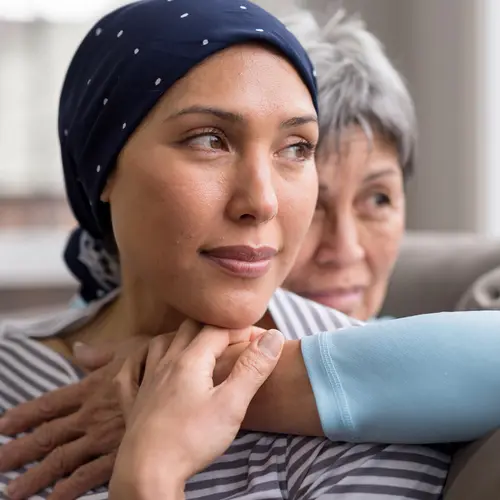When you find out you have advanced breast cancer, called metastatic or stage IV cancer, you probably have a lot of questions. That's understandable.
"The goals of therapy are to prolong life while at the same time maintaining a good quality of life," says Julie Gralow, MD, of the Seattle Cancer Care Alliance and the University of Washington School of Medicine.
Although there's no cure, "there is no question that patients are living longer with metastatic disease, and our patients have many more treatment options than even just a few years ago," Gralow says.
It helps to know about each of those options, so you're prepared to talk about the plan your doctor recommends.
Remember that every case is different, so your treatment may not be the same as that of another person with breast cancer. You should talk to your doctor about which treatment is right for you.
Surgery
Many people with breast cancer will need surgery on their affected breast or breasts.
In rare cases, your doctor may also recommend surgery to remove a tumor that's spread to another organ. They typically recommend that if the breast cancer is very limited in its spread.
"When that happens, we can sometimes go in and remove that -- for example, if there's just one small spot on the liver," Gralow says.
Surgery may also help if you have pain that doesn't seem to go away, a weak bone that needs to be stabilized, or another problem.
Radiation
You can't get radiation therapy on a breast that's had radiation before. But you may need radiation to shrink tumors in other parts of your body. It can:
- Stop the cancer from growing and keep symptoms under control. You might, for example, get radiation on a tumor that presses on your spine to make you more comfortable.
- Control bleeding or pain from cancer that's spread to the bone or liver.
For some people, doctors may use "stereotactic" treatment -- highly focused radiation -- to target spots in the liver or the lungs.
Chemotherapy
Most women need chemo when they have advanced breast cancer. And it's likely to be easier to handle than in the past.
"Our aim is to keep the cancer under control for as long as possible with as few side effects as possible," says Virginia Borges, MD, of the University of Colorado-Denver School of Medicine.
There are several chemo drugs your doctor may choose from, depending on your particular case. Some are pills. Others you get through an IV tube in your arm. Talk with your doctor about what you prefer.
Hormonal Therapy
If your cancer is fueled by hormones such as estrogen, you may need to take hormonal therapy. You and your doctor might choose from various types of these drugs. They can lower the amount of estrogen your body makes so it's not available to fuel your breast cancer.
There are different types of hormonal treatments for breast cancer:
Tamoxifen and toremifene (Fareston) block estrogen from stimulating cancer cell growth. Doctors call these drugs "SERMS," which stands for selective estrogen receptor modulators.
Anastrozole (Arimidex), exemestane (Aromasin), and letrozole (Femara) stop the body from making estrogen in women who've gone through menopause.
Fulvestrant (Faslodex) counters estrogen throughout the body, not just in cancer cells. You get it in a shot. It's approved for use in postmenopausal women with advanced breast cancer who've already tried tamoxifen or toremifene.
Goserelin (Zoladex) and leuprolide (Lupron) stop the ovaries from making estrogen. Doctors may consider these meds, along with other hormone drugs, in women who have not yet been through menopause. After stopping these drugs, the ovaries may or may not make estrogen again.
Targeted Treatments
There are drugs that target specific proteins related to cancer.
Everolimus (Afinitor) targets a protein called mTOR, and the drugsabemaciclib(Verzenio), palbociclib(Ibrance) andribociclib(Kisqali)go after a protein called CDK 4/6. They're approved to treat advanced breast cancer in women after menopause if:
- Their disease is sensitive to (meaning fueled by) estrogen. Doctors call this “ER-positive.” Most breast cancers are ER-positive.
- Their cancer is not sensitive to the HER2 protein. Your doctor may call this “HER2-negative.” Most breast cancers are HER2-negative.
Some breast cancers -- about 20% -- make too much of the HER2 protein. They're more aggressive than other cancers. Drugs that target HER2 include:
Trastuzumab (Herceptin) blocks the HER2 protein from stimulating cancers cells to grow. You get it by IV once a week or every 3 weeks as a bigger dose. One of the risks is congestive heart failure, so your doctor will closely watch your heart's health if you take it.
Ado-trastuzumab emtansine (TDM-1, Kadcyla) is like trastuzumab with a chemo drug added to it. You get it by IV every 3 weeks.
Pertuzumab (Perjeta) works similarly to trastuzumab by blocking HER2. Doctors often give it along with the chemo drug docetaxel(Taxotere) and trastuzumab.
Lapatinib (Tykerb) may be an option if chemo and trastuzumab aren't working.
Other Treatments
If the disease is in your bones, you may need another medication, such as:
Denosumab (Prolia, Xgeva). This drug will slow down the growth of breast cancer in your bones, and it protects bones from breaking. It can also lower the blood's calcium level, so your doctor will monitor this. You get a shot of it, usually every 4 weeks.
Pamidronate disodium (Aredia). When breast cancer is in the bones, you may have too much calcium in your blood. This drug lowers your blood's calcium level. You get it by IV, usually every 3-4 weeks. Each session can take 2 or more hours, depending on your particular case.
Zoledronic acid (Zometa). This is the same type of drug as pamidronate disodium. It works the same way to lower your blood calcium level. You get it by IV, which takes about 15 minutes, every 3-4 weeks.
Talk with your doctor about the risks and benefits of each treatment. Keep your personal goals in mind as you decide how best to treat your cancer.

